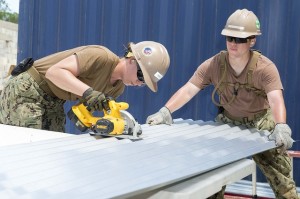 Print a Sign-In Sheet | Spanish Version
Print a Sign-In Sheet | Spanish Version
Hard hats are the best protection from a major head injury. Hard hats should be adjusted to fit as follows:
- The crown straps fit over the top of your head to cushion impact
- The adjustable headband holds the hat securely to your head
- The chin or nape straps keep the hat from being knocked off
- Use a full-brimmed hat to protect against blows to the entire head, neck, and shoulders. Use a visored hat when working in confined spaces.
While using hard hats, you should always:
- Adjust the straps of the hat to your own size
- Keep the headwear clean and in good repair
- Replace worn straps as needed
- Check your hat for cracks before and after each use. Replace a hat that is cracked or has received a major impact.
You should never:
- Use paint or solvents on your hat as they may weaken the hat’s structure
- Use someone else’s hat or give your hat to someone else to use, as it will not fit properly.
Types of protective headwear:
- Class G (General) protects against impact and penetration hazards. Gives low-voltage electrical protection.
- Class E (Electrical) is designed for electrical/utility work, protects against falling objects/ impacts, and protects against high-voltage hazards.
- Class C (Conductive) is designed for comfort and offers limited protection. It protects from minor bumps against fixed objects, but it does not provide protection against falling objects or electrical hazards. If used in a confined space, ensure there are no serious hazards present. NEVER use a bump cap in place of a hard hat.
- Hair covers keep hair from getting caught in moving machine parts. Usually made of fabric, they are adjustable and may have a front visor.
- Special tasks may require other headwear, which include thermal liners for extremely cold temperatures, lamp brackets for work in dark areas, and face shield mounts for use around flying particles.
KEMI does not assume liability for the content of information contained herein. Safety and health remain your responsibility. This information is to be used for informational purposes only and not intended to be exhaustive or a substitute for proper training, supervision or manufacturers’ instructions/recommendations. KEMI, by publication of this information, does not assume liability for damage or injury arising from reliance upon it. Compliance with this information is not a guarantee or warranty that you will be in conformity with any laws or regulations nor does it ensure the absolute safety of any person, place or object, including, but not limited to, you, your occupation, employees, customers or place of business.

